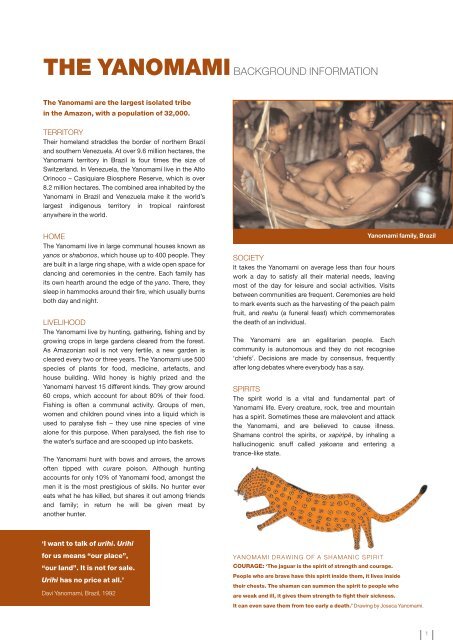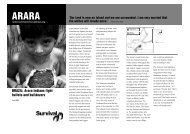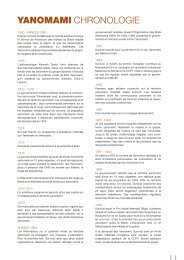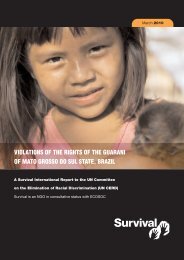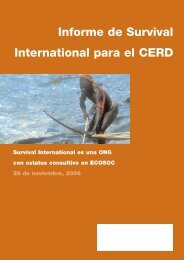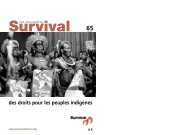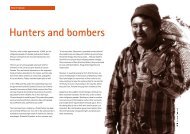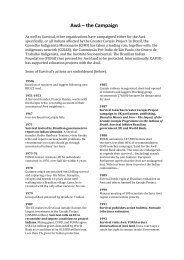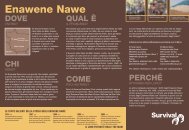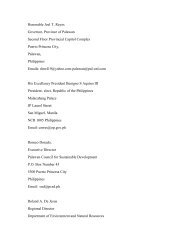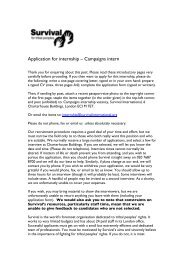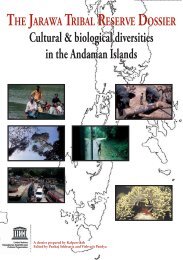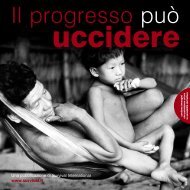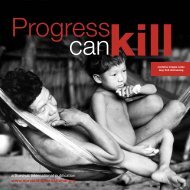The Yanomami - Survival International
The Yanomami - Survival International
The Yanomami - Survival International
Create successful ePaper yourself
Turn your PDF publications into a flip-book with our unique Google optimized e-Paper software.
THE YANOMAMI BACKGROUND INFORMATION<br />
<strong>The</strong> <strong>Yanomami</strong> are the largest isolated tribe<br />
in the Amazon, with a population of 32,000.<br />
TERRITORY<br />
<strong>The</strong>ir homeland straddles the border of northern Brazil<br />
and southern Venezuela. At over 9.6 million hectares, the<br />
<strong>Yanomami</strong> territory in Brazil is four times the size of<br />
Switzerland. In Venezuela, the <strong>Yanomami</strong> live in the Alto<br />
Orinoco – Casiquiare Biosphere Reserve, which is over<br />
8.2 million hectares. <strong>The</strong> combined area inhabited by the<br />
<strong>Yanomami</strong> in Brazil and Venezuela make it the world’s<br />
largest indigenous territory in tropical rainforest<br />
anywhere in the world.<br />
HOME<br />
<strong>The</strong> <strong>Yanomami</strong> live in large communal houses known as<br />
yanos or shabonos, which house up to 400 people. <strong>The</strong>y<br />
are built in a large ring shape, with a wide open space for<br />
dancing and ceremonies in the centre. Each family has<br />
its own hearth around the edge of the yano. <strong>The</strong>re, they<br />
sleep in hammocks around their fire, which usually burns<br />
both day and night.<br />
LIVELIHOOD<br />
<strong>The</strong> <strong>Yanomami</strong> live by hunting, gathering, fishing and by<br />
growing crops in large gardens cleared from the forest.<br />
As Amazonian soil is not very fertile, a new garden is<br />
cleared every two or three years. <strong>The</strong> <strong>Yanomami</strong> use 500<br />
species of plants for food, medicine, artefacts, and<br />
house building. Wild honey is highly prized and the<br />
<strong>Yanomami</strong> harvest 15 different kinds. <strong>The</strong>y grow around<br />
60 crops, which account for about 80% of their food.<br />
Fishing is often a communal activity. Groups of men,<br />
women and children pound vines into a liquid which is<br />
used to paralyse fish – they use nine species of vine<br />
alone for this purpose. When paralysed, the fish rise to<br />
the water’s surface and are scooped up into baskets.<br />
<strong>The</strong> <strong>Yanomami</strong> hunt with bows and arrows, the arrows<br />
often tipped with curare poison. Although hunting<br />
accounts for only 10% of <strong>Yanomami</strong> food, amongst the<br />
men it is the most prestigious of skills. No hunter ever<br />
eats what he has killed, but shares it out among friends<br />
and family; in return he will be given meat by<br />
another hunter.<br />
SOCIETY<br />
It takes the <strong>Yanomami</strong> on average less than four hours<br />
work a day to satisfy all their material needs, leaving<br />
most of the day for leisure and social activities. Visits<br />
between communities are frequent. Ceremonies are held<br />
to mark events such as the harvesting of the peach palm<br />
fruit, and reahu (a funeral feast) which commemorates<br />
the death of an individual.<br />
<strong>The</strong> <strong>Yanomami</strong> are an egalitarian people. Each<br />
community is autonomous and they do not recognise<br />
‘chiefs’. Decisions are made by consensus, frequently<br />
after long debates where everybody has a say.<br />
SPIRITS<br />
<strong>The</strong> spirit world is a vital and fundamental part of<br />
<strong>Yanomami</strong> life. Every creature, rock, tree and mountain<br />
has a spirit. Sometimes these are malevolent and attack<br />
the <strong>Yanomami</strong>, and are believed to cause illness.<br />
Shamans control the spirits, or xapiripë, by inhaling a<br />
hallucinogenic snuff called yakoana and entering a<br />
trance-like state.<br />
<strong>Yanomami</strong> family, Brazil<br />
‘I want to talk of urihi. Urihi<br />
for us means “our place”,<br />
“our land”. It is not for sale.<br />
Urihi has no price at all.’<br />
Davi <strong>Yanomami</strong>, Brazil, 1992<br />
YANOMAMI DRAWING OF A SHAMANIC SPIRIT<br />
COURAGE: ‘<strong>The</strong> jaguar is the spirit of strength and courage.<br />
People who are brave have this spirit inside them, it lives inside<br />
their chests. <strong>The</strong> shaman can summon the spirit to people who<br />
are weak and ill, it gives them strength to fight their sickness.<br />
It can even save them from too early a death.’ Drawing by Joseca <strong>Yanomami</strong>.<br />
1
LAND INVASION<br />
During the 1980s the Brazilian <strong>Yanomami</strong> suffered<br />
immensely when 40,000 goldminers invaded their land.<br />
<strong>The</strong> miners shot them, destroyed many villages, and<br />
exposed them to diseases to which they had no<br />
immunity. Twenty percent of the <strong>Yanomami</strong> died in just<br />
seven years. In 1992, after a long international campaign<br />
– led by Davi, <strong>Survival</strong> and the Brazilian NGO, CCPY (the<br />
Pro-<strong>Yanomami</strong> Commission) – the <strong>Yanomami</strong> Park was<br />
created, and the miners were expelled.<br />
In spite of this historic success, Indians in Brazil still do<br />
not have proper ownership rights over their land. <strong>The</strong><br />
government refuses to recognise tribal land ownership,<br />
despite having signed the international law (ILO<br />
Convention 169), which guarantees this right.<br />
Furthermore, there are many within the Brazilian<br />
establishment who would like to see the <strong>Yanomami</strong> Park<br />
reduced in size and opened up to mining and ranching.<br />
<strong>The</strong> threats to the <strong>Yanomami</strong> are multiplying:<br />
Mining<br />
<strong>The</strong> Brazilian congress is debating a draft bill which, if<br />
approved, will legalise large scale mining in Indian lands<br />
– a move which is bitterly opposed by many indigenous<br />
peoples including the <strong>Yanomami</strong>. Sixty percent of<br />
<strong>Yanomami</strong> territory is covered with requests for mining.<br />
Five years ago, goldminers started to re-invade the<br />
<strong>Yanomami</strong> area. It is estimated that there are now up to<br />
1,000 working there illegally. <strong>The</strong> <strong>Yanomami</strong> are lobbying<br />
the government to remove the miners, but so far it has<br />
taken no action. Concerns are mounting that there will<br />
be a new gold rush, with disastrous consequences for<br />
the <strong>Yanomami</strong>, who fear a repeat of the fatal malaria and<br />
flu epidemics spread by the miners during the 1980s.<br />
<strong>The</strong> Army<br />
<strong>The</strong> army is also stepping up its presence in the area,<br />
and has plans to build more barracks and enlarge its<br />
main airstrip in the <strong>Yanomami</strong> heartland. <strong>The</strong> <strong>Yanomami</strong><br />
fear this will bring in more people and equipment, and<br />
destroy more forest. Soldiers have already prostituted<br />
<strong>Yanomami</strong> women, some of whom have been infected<br />
with sexually transmitted diseases.<br />
Goldminers on <strong>Yanomami</strong> land, Brazil<br />
HEALTH AND EDUCATION<br />
In 1999, a new health initiative – Urihi – was set up.<br />
Independent medical staff were recruited to work<br />
alongside traditional <strong>Yanomami</strong> healers. This<br />
programme – supported by <strong>Survival</strong> and CCPY –<br />
reduced the number of deaths by half. It ended in 2004,<br />
when the Brazilian government took it over by decree.<br />
Spending was doubled but disease rocketed. According<br />
to the <strong>Yanomami</strong>, much money is now wasted on<br />
bureaucracy and infrastructure, and some <strong>Yanomami</strong><br />
communities are receiving dangerously inadequate<br />
medical care.<br />
As a result of their increasing contact with outsiders, the<br />
<strong>Yanomami</strong> and CCPY decided to set up an education<br />
project. <strong>Yanomami</strong> are training to teach reading, writing<br />
and maths in their own communities. Another of the<br />
project’s main aims is to raise awareness amongst the<br />
<strong>Yanomami</strong> of their rights.<br />
In 2004, <strong>Yanomami</strong> from 11 regions met to form their<br />
own organisation, Hutukara (the part of the sky from<br />
which the earth was born) to defend their rights and run<br />
their own projects. This empowering move has helped<br />
strengthen the <strong>Yanomami</strong> as they face a difficult future.<br />
‘I am not saying I am against progress. I think it is very good when whites come<br />
to work amongst the <strong>Yanomami</strong> to teach reading and writing and to plant and<br />
use medicinal plants. This for us is progress. What we do not want are the mining<br />
companies which destroy the forest and the miners, who bring so many diseases.<br />
<strong>The</strong>se whites must respect our <strong>Yanomami</strong> land. <strong>The</strong> miners bring guns, alcohol<br />
and prostitution and destroy all nature wherever they go. For us, this is not progress.’<br />
Davi Kopenawa, <strong>Yanomami</strong> leader and shaman, Brazil, 2003<br />
Photos: Front: © Victor Englebert 1980/<strong>Survival</strong>; back (top)<br />
© Colin Jones/<strong>Survival</strong>; (bottom) Fiona Watson/<strong>Survival</strong>.<br />
2


